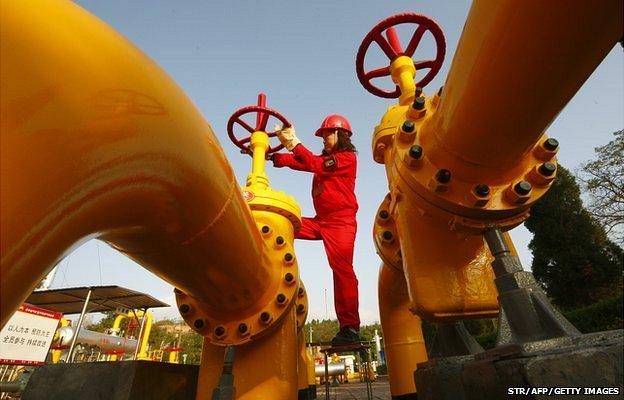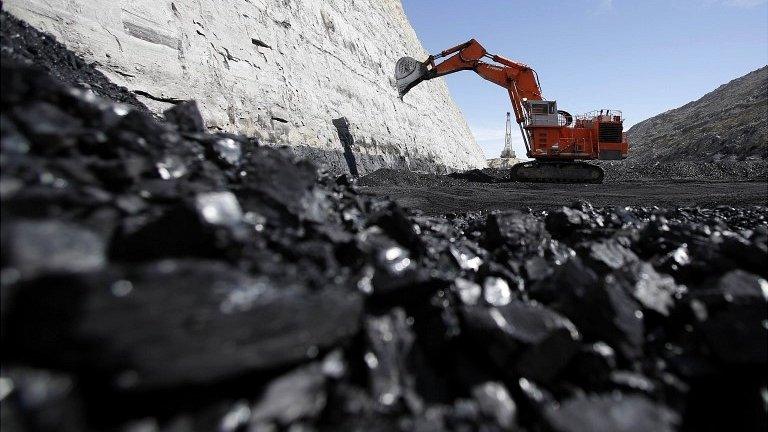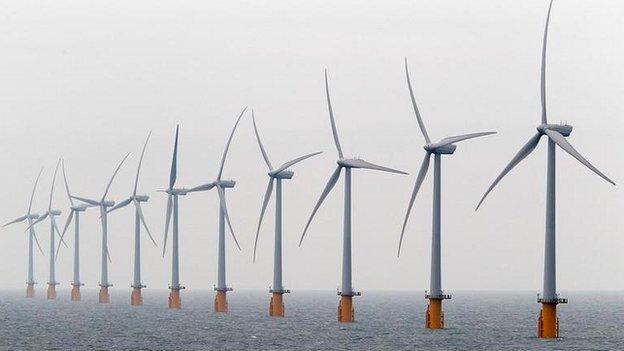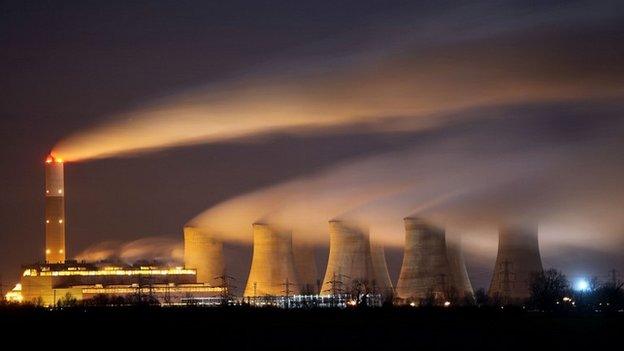Climate mitigation report: Key findings
- Published

The report backs the use of gas as a "bridge technology" in the transition to a low-carbon economy
A UN panel has released its much-anticipated report into strategies for curbing global warming. In their "summary for policymakers", external members of the Intergovernmental Panel on Climate Change (IPCC) say the world must rapidly move away from carbon-intensive fuels. The BBC News website's science editor Paul Rincon breaks down the key findings.
Total anthropogenic GHG (greenhouse gas) emissions have continued to increase over 1970 to 2010 with larger decadal increases toward the end of this period
Here, the IPCC is setting the scene: Mitigation must happen and happen fast against a background of fast-rising CO2 emissions. Greenhouse gas releases were higher between 2000 and 2010 than they have ever been in human history, and the global economic crisis produced only a temporary lull in emissions. In addition, about half of all the carbon that humans have pumped into the atmosphere since 1750 has been emitted in the past 40 years.
Second, CO2 emissions from fossil fuel combustion and industrial processes contributed about 78% of total greenhouse gas emissions from 1979 to 2010. This brings us to another take-home message of this report - that experts believe there needs to be a huge shift towards clean energy and away from carbon-intensive energy sources if we are to head off the worst effects of global warming.
The panel says that, driven by a global increase in population and economic activity, global surface temperature increases will be between 3.7C and 4.8C in 2100 if no new action is taken.
Scenarios reaching atmospheric concentration levels of about 450ppm CO2 equivalent by 2100... include substantial cuts in anthropogenic GHG emissions by mid-century through large-scale changes in energy systems and potentially land use
The figure of 450 parts per million (ppm) concentration of CO2 in the atmosphere is about the limit we must not exceed in order to keep temperature change under 2C (3.6F) by the end of this century. The 2C target was agreed by the UN as a way of avoiding dangerous changes in the climate.
But keeping greenhouse emissions under 450ppm by 2100 will be an uphill struggle. It will involve major changes to the way the world gets its energy - requiring a tripling or quadrupling of the share of low-carbon energy from renewables such as solar and wind, nuclear energy or other less polluting options. It will also necessitate changes in the way we use land, including reforestation - trees absorb CO2 and are therefore a natural "sink" for this greenhouse gas.
The message from the IPCC is that despite the scale of the challenge, the changes required are within our grasp and even offer opportunities (renewables could offer energy security, preventing access to fossil fuel supplies being used as a political weapon).
If the world does overshoot the 450ppm limit, technologies such as Bio-Energy Carbon Capture and Storage (Beccs) might have to be deployed widely. But the panel indicates which scenario would be preferable, pointing out: "The availability and scale of these and other carbon dioxide removal (CDR) technologies and methods are uncertain," and, it adds "associated with challenges and risks".
Since AR4 [the IPCC's previous assessment report in 2007], many RE technologies have demonstrated substantial performance improvements and cost reductions, and a growing number of RE (renewable energy) technologies have achieved a level of maturity to enable deployment at significant scale
Some supporters think that perceptions of renewable energy sources are lagging behind the reality, and this report says that while the sector is growing, renewable technologies still need the support of policy makers if their market shares are to increase.
There will be a price tag: The economic costs of mitigation vary widely depending on the assumptions used in simulations and the technologies deployed. Scenarios that keep atmospheric concentrations of CO2 under 450ppm by 2100 are associated with losses in global consumption (economic activity) of 1% to 4% in 2030, for example.
However, the report warns that if mitigation steps are delayed, or if access to technologies such as Bio-Energy with Carbon Capture and Storage (Beccs) is limited for any reason, the costs of mitigation will increase still further in the medium to long term.
And there are likely to be many other benefits from steps to reduce greenhouse gas emissions, in addition to those related to curbing global warming. The benefits include a reduction in air pollution, which causes millions of premature deaths worldwide each year. Another is energy security - clean energy sources can help reduce our dependence on other countries for supplies of gas, for example.
The report actually backs the use of gas in the switch to a low-carbon economy. It says that efficient natural gas power generation could act as a "bridge technology", if its use is phased out in the second half of this century.
Follow Paul on Twitter, external.
- Published13 April 2014

- Published13 April 2014

- Published13 April 2014
